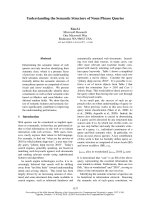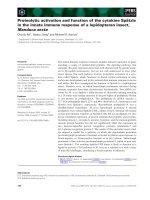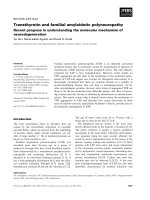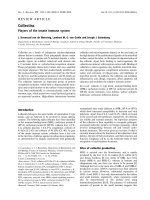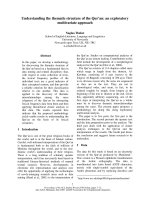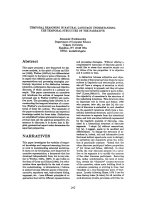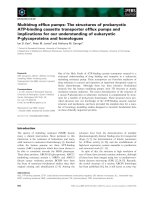Understanding the adaptive immune responses against newly emerged viruses, SARS coronavirus and avian h5n1 influenza a virus 2
Bạn đang xem bản rút gọn của tài liệu. Xem và tải ngay bản đầy đủ của tài liệu tại đây (92.6 KB, 13 trang )
I
TABLE OF CONTENTS
SUMMARY VI
LIST OF TABLES VIII
LIST OF FIGURES IX
ABBREVIATIONS XII
CHAPTER 1: INTRODUCTION
1.1 Overview of emerging infections 1
1.2 Severe Acute Respiratory Syndrome (SARS)
1.2.1 Epidemiology of severe acute respiratory
syndrome (SARS) 2
1.2.2 Genome organization 4
1.2.2.1 Replicase genes 6
1.2.2.2 Structural and accessory proteins 8
1.2.2.3 Accessory 3a protein 15
1.3 H5N1 Influenza A
1.3.1 Epidemiology of H5N1 influenza A virus 18
1.3.2 Genome organization 21
1.3.2.1 Structural and non-structural proteins 23
1.3.2.2 Hemagglutinin protein 27
1.4 Viral infection and the host immune response
1.4.1 Clinical features of SARS and H5N1 influenza 31
1.4.2 Innate immune response against viral infection 34
1.4.3 Adaptive immune response against viral infection 39
II
1.4.3.1 Humoral immune response 39
1.4.3.2 Cellular immune response 41
CHAPTER 2: MATERIALS AND METHODS
2.1. Antibodies and synthetic peptides 44
2.2. Viruses 45
2.3. Mice and immunization 46
2.4. Subjects 46
2.5. Enzyme-linked immunoabsorbent assay (ELISA) 47
2.6. Isolation and culture of splenocytes 48
2.7. Anti-mouse IFNγ ELISPOT assay 48
2.8. Isolation of PBMC and in vitro expansion of SARS-
specific T cells 49
2.9. Anti-human IFNγ ELISPOT assay 50
2.10. Intracellular cytokine staining (ICS) and degranulation
assays 51
2.11. MHC restriction for CD8
+
T cell response 52
2.12. NP44-specific T cell clone activation with endogenous
expressed NP protein by BCL 52
2.13. Western blotting 53
III
2.14. Pseudotyped particle neutralization assay 54
2.15. Proliferation assay 55
2.16. Production and screening of hybridoma 56
2.17. Fluorescent activated cell sorting (FACS) 56
2.18. Radiolabeled immunoprecipitation 57
2.19. Micro-neutralization assay 58
2.20. Hemagglutination inhibition (HI) assay 58
2.21. Epitope mapping of mAb 59
2.22. Furin cleavage assay 59
2.23. Virus binding assay 60
2.24. Post-attachment assay 60
2.25. Protease susceptibility assay 61
2.26. Passive immunization and virus challenge 61
CHAPTER 3: MEMORY T CELL RESPONSE IN BALB/C MICE AND
SARS-RECOVERED INDIVIDUDALS
3.1. Immune response against SARS accessory 3a protein in
Balb/c mouse model 63
IV
3.2. Memory T cell responses against SARS structural
nucleocapsid (NP) and accessory 3a protein in SARS-
recovered patients 67
3.2.1. CD4
+
and CD8
+
T cell response in SARS individuals 71
3.3. Cytokine profile of CD4
+
and CD8
+
T cell response 78
3.4. Discussion 84
CHAPTER 4: FURTHER CHARACTERIZATION OF CD8
+
T CELL
REPONSE
4.1. MHC class I restriction of the CD8
+
T cell response 92
4.2. NP44 T cell clone recognizes endogenous presented peptide 96
4.3. Discussion 98
CHAPTER 5: IMMUNE RESPONSE AGAINST RECOMBINANT H5N1
HEMAGGLUTININ (rHA) PROTEIN
5.1. Neutralizing humoral response against baculovirus-
expressed recombinant HA in Balb/c mouse 102
5.2. T cell response against baculovirus-expressed
recombinant HA in Balb/c mouse 107
5.3. Monoclonal antibody production against baculovirus-
expressed recombinant HA
5.3.1. Characterization of monoclonal antibody mAb
9F4 109
5.3.2. Immunoprecipitation of mature HA protein by
mAb 9F4 111
V
5.4. Neutralizing ability of mAb 9F4
5.4.1. Neutralizing ability against homologous strain 113
5.4.2. Cross neutralization ability against other H5N1
strains and other subtypes of influenza A strains 114
5.4.3. Microneutralization assay using live H5N1
strains 116
5.5. Discussion 117
CHAPTER 6: FURTHER CHARACTERIZATION OF MONOCLONAL
ANTIBODY, 9F4
6.1. Epitope mapping of 9F4
6.1.1. Binding to internal deletion and substitution mutants 120
6.2. Mechanism of inhibition
6.2.1. Virus binding and Hemagglutinin inhibition (HI) assay 125
6.2.2. Post-attachment and Proteolysis susceptibility assay 127
6.3. Protection studies of 9F4 in mouse lethal challenge model
6.3.1. Prophylactic and Therapeutic protection 131
6.4. Discussion 135
CHAPTER 7: CONCLUSION AND FUTURE WORK
7.1. Severe acute respiratory syndrome coronavirus 139
7.2. H5N1 influenza A virus 142
REFERENCES 146
APPENDICES 178
VI
SUMMARY
With increasing opportunities for animal-to-human and human-to-
human transmission of infectious pathogens, many new strains of viruses have
emerged. Two recent newly-emerged viruses are the severe acute respiratory
syndrome coronavirus (SARS-CoV) and the H5N1 influenza A virus.
Together with innate immunity, the host adaptive immune responses are
crucial for the clearance of the virus during an infection.
In the first part of this study, the longevity and functionality of SARS-
specific memory T cells were examined. The SARS accessory 3a protein was
first demonstrated to elicit humoral and T cell response in a mouse model.
The study was extended to using peripheral blood mononuclear cells (PBMCs)
from 16 SARS-recovered individuals, 4 years post-infection. An unbiased
approach, which is independent of HLA types, was utilized to identify putative
T cell epitopes in the accessory 3a and the nucleocapsid (NP) protein. The
IFNγ ELISPOT and intracellular cytokine staining assays showed that
approximately 50% of them had positive memory T cell responses against the
two proteins tested. CD4
+
T and CD8
+
T cell responses were observed
following stimulation with a pool of overlapping peptides spanning the entire
NP and 3a proteins. Five potential CD8
+
T cell epitopes were identified.
Among them, peptide NP44 was the most frequently recognized peptide and
3a2, which displayed both CD4
+
and CD8
+
T cell response, was the only
peptide identified in the 3a protein. Cytokine analysis of these T cells
revealed polyfunctional activity. Interestingly, all the CD8
+
T cell epitopes
were restricted by HLA-B subtype. These data can be useful in designing
VII
vaccines against SARS as well as understanding memory T cell responses
against novel acute infections.
In the second part of the study, a neutralizing monoclonal antibody
(mAb) 9F4 against the hemagglutinin (HA) protein of the influenza
A/chicken/hatay/2004 H5N1 virus (clade 1) was generated and characterized.
Firstly, the baculovirus-expressed and purified recombinant HA (rHA) was
shown to elicit neutralizing humoral and T cell responses in the mouse model.
This was followed by the production of mAb 9F4 using the rHA. MAb 9F4
binds both the denatured and native forms of HA and recognizes the HA
proteins of three other heterologous strains of H5N1 viruses. By using
lentiviral pseudotyped particles carrying HA on the surface, mAb 9F4 was
shown to effectively neutralize the homologous and other H5N1 strains
belonging to clade 1, 2.1 and 2.2 but not other subtypes of the influenza A
virus. Epitope mapping analysis revealed that mAb 9F4 binds a previously
uncharacterized and well-conserved epitope below the globular head of the
HA
1
subunit. MAb 9F4 does not block the interaction between HA and its
receptor but prevents pH-mediated conformation change of HA which is
necessary for the fusion step during viral entry. It was also found to be
protective, both prophylactically and therapeutically, against lethal viral
challenge of mice. Our data suggest that mAb 9F4 could be a potential
candidate for immunotherapy. It also provided new information on a novel
neutralizing epitope, yielding a new avenue for the design and development of
a universal vaccine against H5N1.
VIII
LIST OF TABLES
Table 1.1: Summary of the SARS-CoV structural proteins. 9
Table 1.2: Summary of the SARS-CoV accessory proteins. 12
Table 1.3: Summary of structural and non-structural
proteins of the H5N1 virus. 23
Table 1.4: Antiviral effects of antibody. 39
Table 3.1: Summary of memory T cell response in all the
16 SARS-recovered individuals. 75
Table 3.2: Summary of CD4
+
memory T cell response in
SARS-recovered individuals. 76
Table 3.3: Summary of CD8
+
memory T cell response in
SARS-recovered individuals. 77
Table 4.1: Summary of HLA-restriction of CD8
+
T cell
response in SARS-recovered individuals. 95
Table 5.1: Microneutralization assay using two live H5N1
influenza A viruses belonging to clade 2.2.2. 116
Table 6.1: Hemagglutination inhibition assay using two
live H5N1 influenza A viruses belonging to
clade 2.2.2. 127
IX
LIST OF FIGURES
Figure 1.1: Summary of the SARS-CoV genome
organization and viral protein expression. 7
Figure 1.2: Diagram showing the phylogenetic tree for the
hemagglutinin gene of highly pathogenic avian
influenza A (H5N1) viruses. 20
Figure 1.3: Hypothetical mechanism for membrane fusion
by hemagglutinin protein. 30
Figure 3.1: Expression of SARS-CoV 3a protein. 65
Figure 3.2: Immune response against 3a protein in Balb/c
mouse. 66
Figure 3.3: ELISPOT analysis of healthy and SARS-
recovered individuals. 70
Figure 3.4: Summary of the positive in vitro ELISPOT
results of all 16 SARS-recovered individuals. 71
Figure 3.5: Example of an ELISPOT data analysis. 72
Figure 3.6: Representative data of the SARS-specific CD4
+
and CD8
+
T cell response. 74
Figure 3.7: Distribution of CD4
+
T cell response within
each individual with multiple CD4
+
T cell
responses. 76
Figure 3.8: Distribution of CD8
+
T cell response within each
individual with multiple CD8
+
T cell responses. 77
Figure 3.9: Representative data of the cytokine profile of
CD4
+
T cell response stained with Th1/Th2
cytokines. 80
Figure 3.10: Representative data of the cytokine profile of
CD4
+
T cell response stained with inflammatory
cytokines. 81
Figure 3.11: Representative data of the cytokine profile of
CD8
+
T cell response stained with Th1/Th2
cytokines. 82
X
Figure 3.12: Representative data of the cytokine profile of
CD8
+
T cell response stained with inflammatory
cytokines. 83
Figure 3.13: Amino acid sequence alignment of the 3a
protein of three different strains of the SARS
corovnavirus. 88
Figure 3.14: Amino acid sequence alignment of the
nucleocaspid (NP) protein of three different
strains of the SARS corovnavirus. 89
Figure 4.1: T cell activation after incubation with correct
EBV-LCL pulsed with SARS peptide. 94
Figure 4.2: Summary of CD8
+
T cell response for all HLA-
B*4001
+
individuals among the 16 SARS
individuals tested. 95
Figure 4.3: NP44-specific T cell clone activation with
endogenous peptide presented by HLA-B*4001
+
EBV-LCL. 97
Figure 4.4: Expression of SARS-CoV NP protein using NP-
expressing vaccinia virus construct. 98
Figure 5.1: Antibody response against baculovirus-
expressed recombinant HA in Balb/c mouse. 103
Figure 5.2: Detection of HA and p24 proteins of the
Hatay04-HApp. 105
Figure 5.3: Neutralizing antibody response against
baculovrius-expressed recombinant HA in
Balb/c mouse. 106
Figure 5.4: T cell response against baculovirus-expressed
recombinant HA in Balb/c mouse. 108
Figure 5.5: MAb 9F4 binds both native and denatured forms
of HA. 110
Figure 5.6: MAb 9F4 immunoprecipitates the mature form
of HA. 112
Figure 5.7: MAb 9F4 prevents entry of Hatay04-HApp. 113
XI
Figure 5.8: MAb 9F4 prevents the entry of HApp of other
clades of H5N1 virus, but not that of HApp from
other subtypes (H1N1 and H3N2) of influenza
virus. 115
Figure 6.1: A schematic diagram showing the C-terminal
truncation, internal deletion, single and double
substitution mutants of Hatay04-HA. 122
Figure 6.2: Residues 260 to 263 in HA are important for the
binding of MAb 9F4. 123
Figure 6.3: Internal deleted mutant HAs can be cleaved by
furin. 124
Figure 6.4: MAb 9F4 does not inhibit cell binding of
Hatay04-HApp. 126
Figure 6.5: MAb 9F4 acts by inhibiting the fusion step of
viral entry. 129
Figure 6.6: MAb 9F4 inhibits the acquisition of protease
sensitivity of the HA protein at pH 5. 130
Figure 6.7: Prophylactic protection against Smew06 by
MAb 9F4. 133
Figure 6.8: Therapeutic protection against Smew06 by MAb
9F4. 134
Figure 6.9: Protein sequence alignment for residues 254 to
270 in HA of the H5N1 influenza A viruses. 136
Figure 6.10: A ribbon representation of the trimeric VN04
HA protein. 136
XII
ABBREVIATIONS
ACE2 angiotensin-converting enzyme 2
Ad5 adenovirus 5
ADP adenosine diphosphate
AIDS acquired immunodeficiency syndrome
ARDS acute respiratory distress syndrome
BSA bovine serum albumin
CD cluster of differentiation
CFA complete Freund’s adjuvant
CTL cytotoxic T lymphocytes
DAD diffuse alveolar damage
DC dendritic cell
EBV Epstein-Barr virus
ELISA enzyme-linked immunoabsorbent assay
ELISPOT enzyme-linked immunospot
ER endoplasmic reticulum
FBS fetal bovine serum
FITC fluorescein isothiocyanate
GM-CSF granulocyte macrophage colony-stimulating
factor
GST glutathione-S-transferase
HA hemagglutinin
HApp lentiviral pseudotyped virus expressing
hemagglutinin
Hatay04 A/chicken/hatay/2004 (H5N1)
HI hemagglutination inhibition
HIV human immunodeficiency virus
HLA human leukocyte antigen
HPAI highly pathogenic avian influenza
HRP horseradish peroxidase
ICS intracellular cytokine staining
IFA incomplete Freund’s adjuvant
IFN interferon
IFNAR1 IFN alpha-receptor subunit 1
IL interleukin
IND06 A/Chicken/India/NIV33487/06 (H5N1)
Indo05 A/Indonesia/5/2005 (H5N1)
mAb monoclonal antibody
MAPK mitogen-activated protein kinase
MBL mannose-binding lectin
MCP monocyte chemoattractant protein
MDCK Madin-Darby canine kidney
MHC major histocompatibility complex
MHV murine hepatitis coronavirus
MIP macrophage inflammatory protein
mRNA messenger ribonucleic acid
NA neuraminidase
NF-κB nuclear factor kappa B
XIII
NHBE normal human bronchial epithelial
NK natural killer
Nsp non-structural protein
Nt nucleotide
ORF open reading frame
PA polymerase acidic
PB polymerase basic
PBMC peripheral blood mononuclear cells
PBS phosphate buffered saline
PCR polymerase chain reaction
PHA phytohemagglutinin
PKR protein kinase R
RBD receptor binding domain
rHA recombinant hemagglutinin
RNA ribonucleic acid
RT-PCR reverse transcriptase polymerase chain reaction
SARS severe acute respiratory syndrome
SARS-CoV severe acute respiratory syndrome coronavirus
SDS-PAGE sodium dodecyl sulfate polyacrylamide gel
electrophoresis
SEB staphylococcal entertoxin B
SFU spot forming unit
Swan06 A/MuteSwan/Sweden/V827/06 (H5N1)
Smew06 A/Smew/Sweden/V820/06 (H5N1)
TCID tissue culture infective dose
TCR T cell receptor
TNF tumor necrosis factor
UTR untranslated region
VLP virus-like particle
VN04 A/Viet Nam/1203/2004 (H5N1)
vRNP viral ribonucleoproteins
WHO World Health Organization

